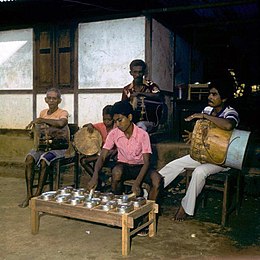music.wikisort.org - Instrument
A tifa totobuang is a music ensemble from the Maluku Islands, related to the kulintang orchestra. It consists of a set of a double row of gong chimes known as the totobuang (similar to set of bonang gong chimes) and a set of tifa drums. It can also include a large gong.[1]
 A Tifa totobuang ensemble, a traditional musical instrument from the East Indonesia region | |
| Classification |
|
|---|---|
| Developed | Indonesia (Maluku) |
| Playing range | |
| Pelog and Slendro scales | |
| Related instruments | |
| bonang, kenong, canang, keromong, kromong, kethuk, trompong/terompong, rejong, khong wong yai/khong wong lek, khong toch/ khong thom, khong vong, krewaing/krewong | |
| More articles or information | |
 |
| Music of Indonesia |
| Genres |
|---|
|
| Specific forms |
|
|
|
|
|
| Regional music |
|
The name comes from the instruments' collaboration. The ensemble can accompany the Maluku Island's Sawat Lenso dance.[2][3]
The custom dates back at least to the late 17th or early 18th century. Gong-chime and drum ensembles, labeled tifa totobuang, were mentioned by François Valentijn, a Dutch army cleric who served in the Dutch army in Ambon, Maluku in two tours, 1686-1994 and 1703-1713.[4] Valentijn talked about hearing "some Javanese lasses sing to the sound of a gong and a tifa (i.e. drum) and of a native zither...a large number of gongs and tifas."[5]
Instruments
Tifa
The tifa drums used for the tifa totobuang have been classed into five sizes. These include, from smallest to largest:[6]
- tifa jekir
- tifa dasar (basic tifa)
- tifa potong
- tifa jekir potong
- tifa bas (bass tifa)
Each size of instrument has a different sound, and they are blended together in the orchestra.[6] Different images and videos of the tifas being played show them drummed with empty hands, with sticks and with a combination of the two.
Totobuang
The totobuang is a set of gong chimes. Photos show the instrument in more than one configuration. One is laid out the same as the bonang, in two equal rows.[7] Other images show a square pattern of 9 or 16 gong chimes.
Jaap Kunst, a musicologist who wrote about Javanese music, said that totobuang was probably another word for bonang which could be used for any instrument played with a hammer.[5]
Sawat dance
The tifa totobuang played music oriented toward Christians, up until 2000, when there were riots in Ambon.[8] After that, the instrument began to play in cultural events with more "Islamic and Malay nuances."[8] The Sawat dance is associated with traders, Arabs who traded in the "Al-Muluk peninsula". The Lenso is a dance from Christian areas, backed by tambourines, drums, or tifa totobuang. [2] The two were deliberately combined into the modern Sawat by a group of women who wanted to dance together.[2] The result is a modern product that combines two of the country's separate arts, one music and one dance.[8]
Gallery
- Musicians playing totobuang gong chimes and tifa drums at Amahusu.
- Musician playing tifa drum during tug-of-war matches at Ullath.
- Musician's playing tifa drum at Amahusu.
See also
- Gamelan
- Kulintang
- Talempong
- Kolintang
- Music of Indonesia
- Tari Saureka Reka, Indonesian Wikipedia article about the Sawat dance.
References
- "19 Alat Musik Tradisional Indonesia (Universal Update) [translation: 9 Indonesian Traditional Musical Instruments (Universal Update)]". Archived from the original on 14 November 2013.
- "Sawat Lenso, a Maluku dance which is a symbol of friendship between Muslims and Christians". British Broadcasting Corp., Indonesia. 19 January 2019.
- Djarujm Foundation, IndonesiaKaya. "Tifa Totobuang".
[Video. From print on bottom of video:] The totobuang is a melodic musical instrument that has tones and is shaped like a Javanese gamelan instrument...The two are usually played together on the same day, which is why the collaboration is called tifa totobuang.
- Margaret J. Kartomi (September 1995). ""Traditional Music Weeps" and Other Themes in the Discourse on Music, Dance and Theatre of Indonesia, Malaysia and Thailand". of Southeast Asian Studies. Cambridge University Press on behalf of Department of History, National University of Singapore. 26 (2): 367.
- Jaap Kunst. Music in Java, Its history, its theory and its technique, 3rd edition. Vol. 1. The Hague: Martinus Nijhoff. p. 114.
- Kun Setyaning Astuti; Gary G. McPherson; Bambang Sugeng; Nila Kurniasari; Tutut Herawan; Christopher Drake; Ashadi; Endah Retnowati; Adi Cilik Pierewan (27 November 2019). 21st Century Innovation in Music Education: Proceedings of the 1st International Conference of the Music Education Community (INTERCOME 2018), October 25-26, 2018, Yogyakarta, Indonesia. Routledge. p. 443.
- Uru Walu. "Tifa totobuang "Soulutuhua" Naku".
Photo showing 16 gong totobonang and a variety of tifa drums.
{{cite web}}: External link in|quote= - Phosphone/IndonesiaKaya. "Harmonisasi Budaya Dalam Alunan Nada Tifa Totobuang [translation:Cultural Harmonization in Tifa Totobuang's Strains]".
External links
- Video: a tifa totobuang ensemble playing in an indoor setting, showing both totobuang chimes and tifa drums.
- Video: a tifa totobuang ensemble playing in an outdoor setting, showing both totobuang chimes and tifa drums.
- Photo: example of a large tifa drum.
- Photo: example of smaller tifa drums
- Video. Students playing a different configuration of totobuang gong chimes in 4 rows.
- Photo: Totobuang gong chimes (front), tifa drums (back) in Banda Neira, Maluku, Indonesia.
- Photo: woman playing totobuang gong chimes in Banda Neira, Maluku, Indonesia.
Другой контент может иметь иную лицензию. Перед использованием материалов сайта WikiSort.org внимательно изучите правила лицензирования конкретных элементов наполнения сайта.
WikiSort.org - проект по пересортировке и дополнению контента Википедии


